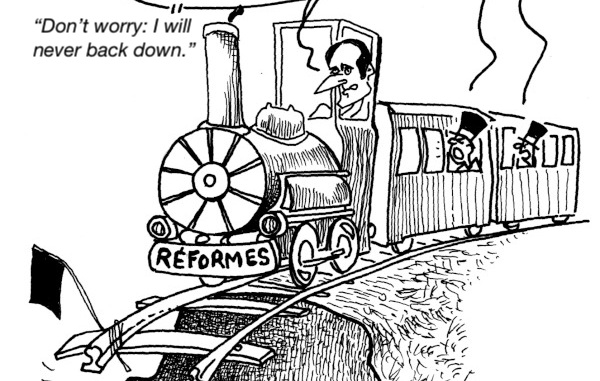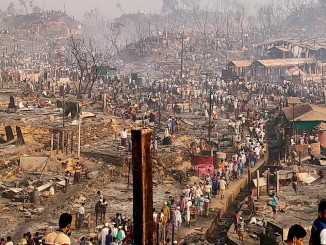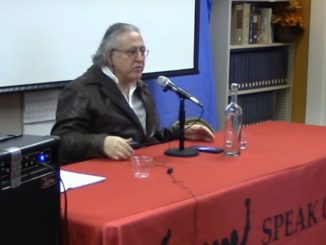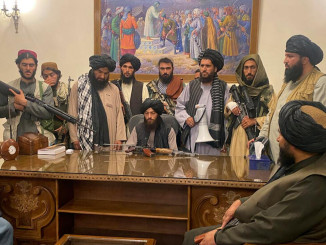
Translated by Speak Out Now: www.speakoutsocialists.org
Translated from Convergences Révolutionnaires – Special Issue; December 2019; www.convergencesrevolutionnaires.org
At the Élysée and Matignon palaces, the officials residences of the government officials, December 7-8 was “hot”: Édouard Philippe summoned his main executives in special sessions, Transport State Secretary Jean-Baptiste Djebbari, Minister of Health and Insurance Agnès Buzyn, Budget Minister Gérald Darmanin and the now famous High Commissioner Jean-Paul Delevoye. Édouard Philippe did not forget to consult the Minister of Education Jean-Michel Blanquer and the super-cop Christophe Castaner. Emmanuel Macron himself took part in these (probably tense) camera sessions.
At the same time, to add to their stress, the management of the SNCF (the public train company) announced to customers through the media, that it would be dangerous to rush to the train stations on Monday morning, December 9th due to possible crowding. However, there are not many trains in the rather strangely deserted train stations. In short, if the traffic is “extremely disturbed”, the power and the leadership of the SNCF are also disturbed on this fifth day of total paralysis by the strike of the railroad workers, the RATP (subway) workers in Paris, the teachers nationwide, and workers in a few other sectors, — disturbed above all on the eve of a new national strike day: Tuesday the 10th, after that of Thursday the 5th, the success of which has led to the beginning of a mobilization that is not yet general though clearly exuberant. Yes, step away from the edge of the platform!
Deep Roots
It’s obviously impossible to predict what will happen to this movement in a few days or weeks, but the roots of anger are too deep to be easily brushed aside. Rage is crystallizing today not only against pension reform, but against all of Macron’s policies, and the world of his rich cronies. The world of working people is rising up against a policy of impoverishment of the working classes and widening inequalities that benefit the exploiters. This mobilization already has a history.
After the spring of 2016 struggle against the Labor Law, and a new railway strike in 2018, anger took a major leap in the shape of the Yellow Vest movement just over a year ago. In that movement, the showdown against Macron, friend of the bosses, took the unprecedented trajectory of a mobilization outside the control of hardened trade union leaders. Seven months ago, hospitals organized themselves in an “Inter-Emergency-Room Collective” and then turned to other sectors, without the authorization or approval of the trade union organizations. Last June, teachers across the country, also out of the ordinary, organized against alleged education reforms by protesting the sacrosanct baccalaureate out (this is a graduation test for 12th graders). On September 13th, another thunderclap was heard, when Parisian subway and bus workers went on a one-day strike, at the call of an ordinary inter-union meeting, which would have normally postponed such a strike for three months to allow for time to “study”, to calm things down, and wait for the next stage of the fight. This was the how the December 5th action originated, a beacon of light in the mist, that railroads workers and hospital workers have made shine by not waiting, for some far-off day without any planned follow up, under the control of the union leaderships. Throughout the country in mid-October, railway workers have “laid down their work bags” unexpectedly, due to the understaffing that exposes them to aggression from angry passengers, and to accidents; shop stewards initiated strikes of several days without giving any warning; and then hospital workers, at the call of a multitude of collectives, forced their union leadership to rally as well, and managed a spectacular day on November 14 with tens of thousands of hospital workers in the street, including doctors. They launched an “inter-hospital collective”, which is unusual.
These expressions of anger from the depths have pricked union federations and confederations, like a dagger in the back, and this is a leadership that was already hit hard by the Yellow Vests, who burst on to the scene, bursting people’s illusions in these union apparatuses. So, little by little, the union calls for a December 5 strike multiplied, and rarely were calls by the union followed with such great militancy on the ground. At the end of November, the flood of protests in opposition to the violence against women, with tens of thousands of women and men, including young people, in the street – showed, in yet another area, that an un-organized base was more likely to make an impact than the union apparatuses dirtied by their “social partnership” with the institutions of power.
A Very Special Day
There is no need to say much regarding the strength of December 5th. The demonstrations were on a scale comparable to those of 2010 against the last massive movement against pension reform. There were four times more people than the biggest protests against the Labor Law in 2016, which totaled 220,000 participants, or the first day of the Yellow Vests, which gathered 280,000 people on roundabouts and in the streets. This December 5th, we saw the total paralysis of transportation, with rates of 85 to 100 percent of workers striking in some sectors of the SNCF (railroad); we saw the near paralysis of the region of Paris with the closure of almost all metro and RER (suburban) lines. To this a spectacular movement of teachers has been added, from primary and secondary schools, with massive strike rates of 45 percent, unprecedented in that sector since 2003.
Strikes have also occurred in all other public services and in private companies, although the numbers are much smaller there – and much less well known. The employers took the initiative, and recommended that workers take days off, or telecommute, or even required executives to find a hotel room … The bosses of PSA (auto), those cautious and mischievous monkeys, decided to give the workers two days off on the pretext of transportation difficulties, and thus they could not be counted amongst the strikers. And the government, through the voice of its Minister of the Interior and prefects, tried to stir up fear, announcing there would be violence, and black blocs, in order to dissuade good citizens from taking to the streets.
In the street, there was a tidal wave of nearly a million protesters. Workers in the public and private sectors marched side by side with high school and university students all across the country. Not only did they march shoulder to shoulder, but they talked to each other more than ever. The sound trucks of trade unions were largely drowned out. The pleas to Macron, to the tune of “Little Santa Claus” (a traditional Christmas song), remained minor and laughable.
The streets were flooded with a determined and enthusiastic flow of people expressing the collective strength of these great days. Many discussions took place in streets that were turned into forums – involuntarily encouraged by the cops who delayed the marchers by setting up blockades, and imposing hours of being stuck in one spot; time which was well-used in Paris! Protesters from many sectors have pointed out that the number of those present in the demonstrations was much greater than at the general assemblies, when they could take place, because the transportation difficulties generated crowds of people in the early morning! And this day had a future given that a great majority of railway workers, RATP workers and teachers were already on “renewable” or “unlimited” strikes, scheduled to continue in the following week, regardless of breaks scheduled over the weekend.
The Government Trembles … and Tries to Maneuver!
The force of December 5th led to the immediate – but subtle – backpedaling of the government. The signal was evidently given to the ministers and deputies to soften their tone by the end of the afternoon. Édouard Philippe put forward a calendar for the presentation of the reform in the middle of the following week and hastened to thank the union leadership for the good behavior in the marches (although Castaner mobilized his cops to make trouble)! And on the evening of December 9th, Édouard Philippe felt compelled to improvise a media intervention, addressed mainly to the union leaders who had met that same morning and who, so as not to remain on the sidelines of the movement, had provided strikers with a new goal in the form of a call for a new national day of strikes and demonstrations on Tuesday, December 10th.
Edward Philippe pretended to stay strong, and to remain firm on his “universal” reforms. But anxiety is brewing in high places, and on the eve of the sixth day of the strike, the government does not yet know what it can do to “appear to yield without actually yielding”- if there is still time!
The maneuvers and calculations are visible, and of two kinds, which are superimposed: on the one hand, to improve the so-called social dialogue with the unions – and in doing so, facilitate a comeback for trade union leaders that have been pretty discredited in recent times, although they still have the not negligible power to set dates for the movement. On the other hand, the government is playing on the divisions between workers, in the public and private sector, and between the different sectors of public service itself, promising railway workers a grandfather clause, promising teachers better wages in 2021, if … if… the trade union leaders could jump into the breach and get involved. The CGT and SNCF, for example, have denounced the government plans for retirement, but they have already put forward “specific” railroad workers demands and they have already sat down at the negotiation table to win… but now are coming back for more!
Philippe Martinez himself (well-known head of the CGT union) concentrates in his person the essence of union contradictions: he talks about the withdrawal of the retirement plan but nevertheless demands negotiations for the improvement of the pension system; he refuses to talk with the government, but it is a refusal of the 23rd hour, because he has already negotiated 22 times before! The CGT federation of railway workers is calling for the strike to be extended next Tuesday, but welcomes the opening of “round table discussions” with the SNCF management on that day, etc., etc. And not to mention, of course, the CFDT (Socialist Party union) whose leader supported the government’s pension reform by “points”.
The government and the union leadership are engaging with each other like two feverish parties, who do not know how far to take their little bargaining game for two. The government may find its salvation in the union’s ultimate complacency. Yet the union bosses not in a strong position, because they are far from being able to calm the mobilized popular classes. The situation offers trade union apparatuses an opportunity to make a big show of being radical, but it is very fragile given how they were discredited during the struggle of the Yellow Vests; a combative part of the working class that the union leadership despised and left out in the cold. The Prime Minister would like to find the “intermediary” that they lack in the trade union leadership, capable of channeling the movements. They may indeed manage to channel the movement, with their pretense at fighting with each, but it’s not over, and it may not succeed!
In Spite of the Maneuvers, the Strikers go on Strike!
The success of December 5th pushed the union confederations to call for another strike on December 10th. The new day is being prepared by the railway workers, RATP workers, teachers, but also public finance officers and many other employees of the public and private sectors. Could the contagion spread? It is already palpable. Unlike what the official propaganda would have us believe, SNCF or RATP workers aren’t fighting for special deals and so-called privileges. This movement is not corporatist; the strikers of the mobilized sectors are moving forward consciously and explicitly to fight for the social and political interests of all the workers. As in many other countries of the world, glaring inequalities are no longer being tolerated, and the impoverishment of young and old is no longer acceptable. It is certainly less risky to strike in the public services than in the private sector, as precariousness is widespread. However, the combativity can also be explained by the working conditions of those who use the services and are in contact with strikers: the transport passengers, the schoolchildren, hospital patients who can no longer bear the abuse because of carelessness in high places, and the lack of staffing and resources. This dimension also explains the political rage felt against a government and system that is trampling on the common welfare.
The ball is now in the striker’s court, which is made up of an overwhelming majority of workers who are not in the unions – because the unions have been deserted – and there is also an active minority of grassroots union activists who do not defer to their “superiors” with a curtsy and a bow. In this strike, strikers very quickly organized themselves in various ways: there are general assemblies in railway stations or SNCF yards, bus depots or metros, in meetings of teachers who must regroup in larger assemblies, based on the wide dispersal of their workplaces. Very soon, the desire manifested itself to connect with others, railway workers to teachers, students to assemblies of working people. Hence assemblies developed called “inter-pro” (inter-professional). These were made possible often at the instigation of activists but also by the powerful feeling that we could only make progress together. The process is in its infancy, the size of these structures was certainly limited by the difficulties of transportation, by the need to find someone to take care of the kids, etc., but it is happening.
Everywhere, groups of 100 to 150 strikers and supporters in solidarity met, some gathering beforehand, to prepare for December 5th. These meetings have been the place for numerous discussions, the preparation of joint actions, for deciding the start time for events, and making banners. In some SNCF stations – a couple of handfuls – strike or mobilization committees have been proposed in the daily general assemblies at the initiative of far-left activists, in order to continue the strike, to organize collective discussions, and determine the strike’s orientation and actions. The general idea is that the strike belongs to the strikers, and everyone must ensure its conduct and success, whether unionized or not, belonging to a particular union or not. It is the task of the moment to have everyone act together, within power structures where they are the ones who control and decide how to lead their own movement, instead of remaining isolated or split under different union labels in what some would call a “united front”. This democracy is coming into existence at the “base”, in stations, offices, schools and building sites, just as a democracy of the Yellow Vests was born on the roundabouts. But this democracy must also be coordinated at higher levels, to give a leadership at all levels, including regionally and nationally.
This is a revolutionary perspective, which may seem ambitious or even unrealistic to some, but nevertheless is in synch with the aspirations of a great many of those engaged in a large number of protest movements that are exploding spectacularly in the world today. This perspective is in synch with the legitimate aspirations of the actors in these movements: the hundreds of millions of active or unemployed workers, many of them young, and on whom the production of social wealth is based, who are impoverished and even sometimes homeless. They want to finally play their own role, rather than to “be governed”.
This is happening here in France too. What we hear rising from the mobilization and the demonstrations, is that people are fed-up with “Macron and his world”, fed up with “the power of the rich”… Out with them and their system. The whole problem is precisely what kind of organization workers and young people can create for themselves in order to move in this direction.




